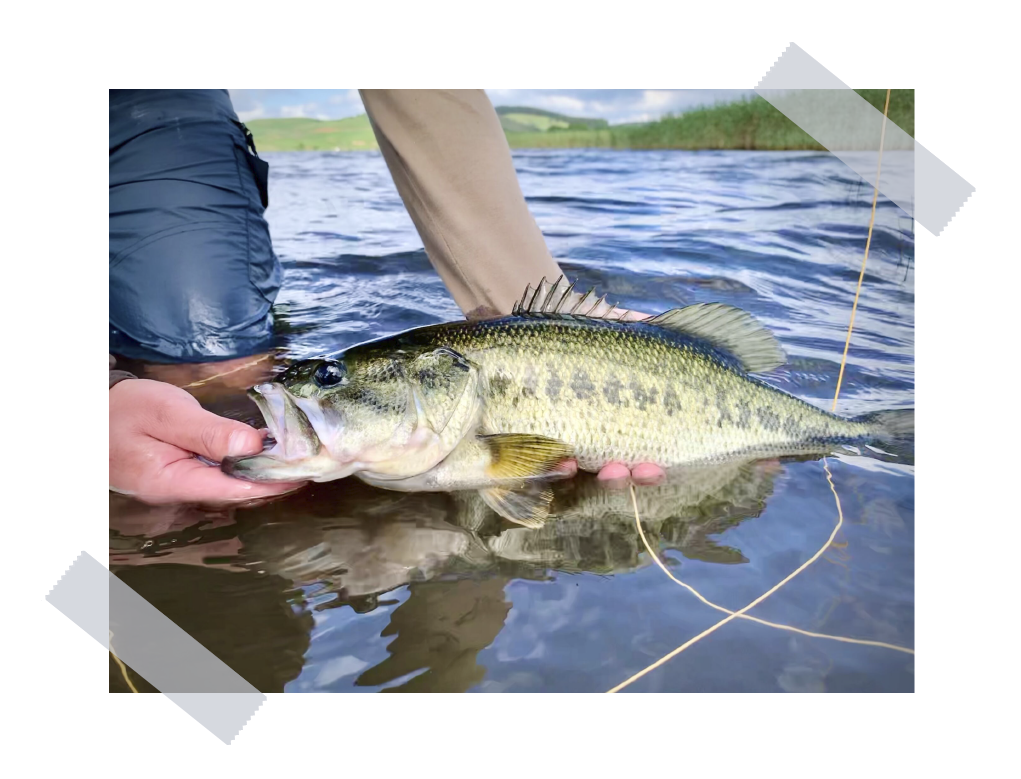CHEERS | FISHING

To trout fishing purists, largemouth bass are sometimes seen as a pest or the enemy, especially since they share habitat with the beloved stippled rainbows and brown trout. But Rhuan Human argues that they offer heaps of fishing pleasure.
Hitting the
Bass note

The occasional curse word after catching a green fish or two when I’ve been casting for something else has indeed slipped over my lips – but more out of frustration at my own angling ability than displeasure at landing the fish.
Full disclosure though, I love bass. They are a wonderful sportfish during spring and summer, so I often pack the car with streamer boxes, some poppers, flippers, and eight-weight rods, to go hunt lunkers.
Bass is the perfect fly fishing quarry because they’ve been introduced to many large impoundments and smaller farm dams all around the country, so it’s one of the most accessible freshwater targets in South Africa. They also present sight fishing opportunities and can be very attuned to the surface – and is by far the most exciting way of catching them. When hunting bigger, solitary fish, they can also be genuinely challenging.

Largemouth bass can be fun when fishing with a fly – as Rhuan Human demonstrates. The best tip is to get a bass fishing friend with a boat to take you to the prime spots in some of the larger dams
Location, location, location
As mentioned, largemouth bass are found in bigger public dams, many of the smaller private farm dams, and some river systems, although they prefer still water and less current. If you intend casting flies in bigger public waterways, a tip is to do so from a boat or other craft suitable for big water fishing. Many of these bigger dams are spot specific for bass and it can be difficult to access them from the bank.
Or do what I do, team up with a knowledgeable local bass angler who knows the spots and is willing to share some insight. It’ll save a lot of time figuring out where the bigger bass are and what they’re feeding on. It might be awkward at first, trying to convince a seasoned bass angler that fly can be an effective way of targeting bass, but once you’ve landed a few on a bass fisherman's boat they warm to the idea of fly fishing and are open to having a go themselves.
Ponds and farm dams are where the fly rod comes into its own. Generally, around springtime, the bass move into the shallows, and a whole new world of sight fishing opportunities arise for fly-rodders. Nothing beats seeing a big hen fish on the shallow banks and flats – and then placing an accurate cast and seeing it aggressively charging to hoover your fly.
How?
Bass are aggressive freshwater predators and generally don't need too much convincing to eat, especially in the warmer months. However, like any other species, the older, more wiser and wily fish are the ones who present a challenge.
For me, the thrill of bass on fly lies in hunting the big “lunkers”, aiming to land a 10lb trophy. I’ve frequently fallen short but any bass in the four pound and up weight class will provide a run for the money and are always fun to catch.
Besides picking the right location, it’s also key to be calculated in approach and strategy. Casting and retrieving through schools of smaller aggressive fish hoping for a bigger bite won’t produce the goods.
Firstly, beef up your tackle. Your six-weight fly rod and trusty old wooly bugger won't cut it. Although lots of fun can be had with lighter fishing tackle, you need a heavier setup that can comfortably deliver a bigger fly accurately and at distance to target bigger bass. Big streamers and poppers are heavier and more wind resistant and therefore an eight-weight or even nine-weight rod and reel combo is effective.
My two preferred line setups are a weight forward floating line with an aggressive taper to help turn over heavy and bulky fly patterns as well as an intermediate line with 1.5 to 3 inch per second sink rates. The floating setup is what I use to cast big poppers, flippers, and foam frogs as well as sparsely tied clousers and brush flies when sight fishing in shallow water.

Bass might not be as pretty as rainbow trout but they provide a lot of sport trying to land them
The intermediate line setup is preferred for larger lakes where we blind fish, looking for cruising and feeding fish. My preference is to use unweighted baitfish imitations that mimic the bass natural prey and favorite fly pattern is an articulated game changer in a variety of colors. It’s very similar in shape and swimming action to that of a jerk bait, a popular conventional bass lure. If you hear a bass angler talking about the "jerk bait" bite being hot right now, strap on a game changer and brace for impact.
The key is to get out there and start catching bass on a fly rod. When summer’s heat puts a halt on still water trout, you can always rely on these aggressive bucket mouths to take a fly. And there’s always the chance of taking a trophy specimen that’ll make any fisherman's day.